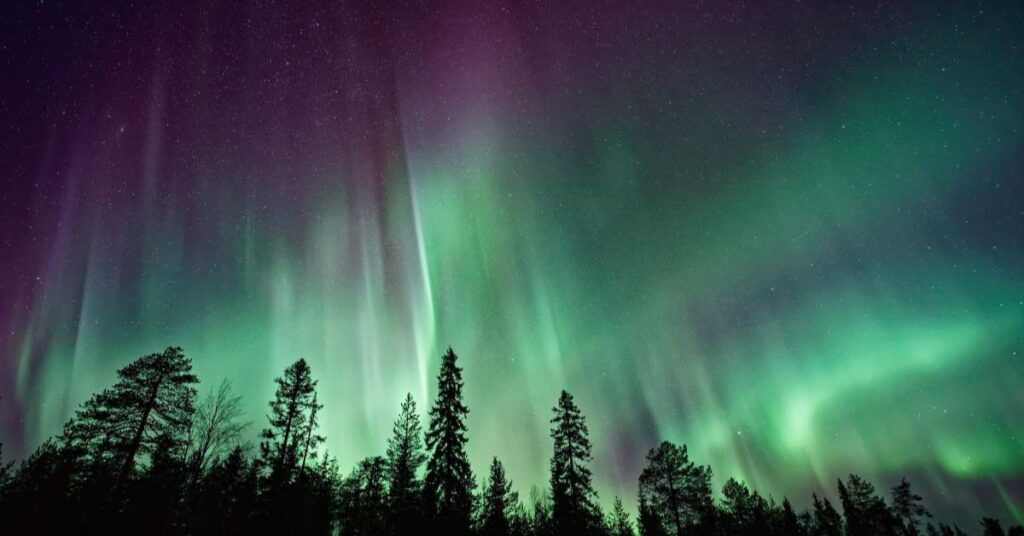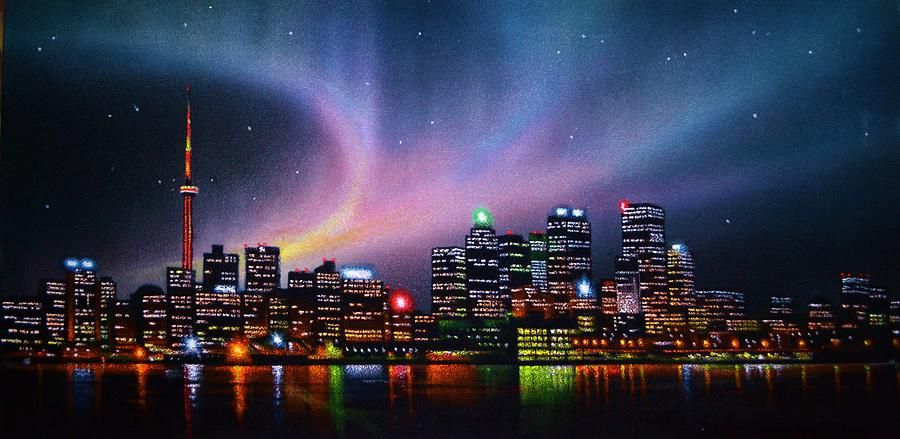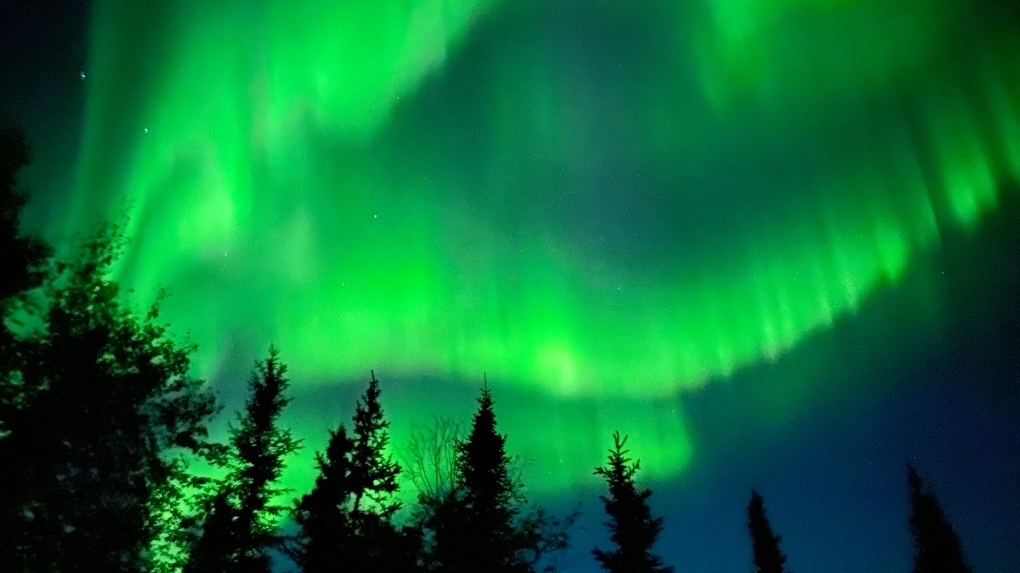The Northern Lights, also known as the Aurora Borealis, is a stunning natural phenomenon that creates mesmerizing displays of colour in the night sky. Although Toronto’s bright city lights make it challenging to see the aurora, some nearby spots offer excellent conditions for viewing. In this blog, we’ll explore the best locations near Toronto, tips on how and when to see the Northern Lights, and address frequently asked questions to help plan your next aurora hunting adventure.
What Are the Northern Lights?
The Northern Lights are caused by charged particles from the sun colliding with the Earth’s atmosphere. This interaction releases energy in the form of light. Which results in glowing, colourful patterns that can range from green to purple. The best chance to witness the Northern Lights occurs in high-latitude regions. But during times of high solar activity, they can sometimes be seen as far south as Ontario.

Can You See the Northern Lights in Toronto?
Seeing the Northern Lights in Toronto is extremely rare due to the city’s light pollution. However, on nights of particularly high solar activity, it’s possible to see faint auroras from the northern outskirts of the city. For a clearer view, you’ll need to travel to locations with darker skies. Fortunately, there are several spots near Toronto where you can increase your chances of catching this incredible sight.
Top 5 Places Near Toronto to See the Northern Lights
Here are some of the best places near Toronto to escape the city lights and increase your chances of seeing the aurora:
Torrance Barrens Dark-Sky Preserve
The Torrance Barrens Dark-Sky Preserve, located about two hours north of Toronto, is the closest and most accessible place for viewing the Northern Lights. The preserve is famous for its wide-open skies, minimal light pollution, and panoramic views, making it a top spot for aurora watchers in Southern Ontario.
- Distance from Toronto: ~2-hour drive (201 km)
- Best Time to Visit: September to March
- Tip: Check solar activity forecasts before heading out to maximize your chances of seeing the aurora.
North Frontenac Dark-Sky Preserve
North Frontenac is known for having some of the darkest skies in Southern Ontario. Located about three hours from Toronto, this Dark-Sky Preserve is a fantastic spot for stargazing and aurora sightings, especially during winter when the nights are clearest and longest.
- Distance from Toronto: ~3-hour drive (285 km)
- Best Time to Visit: October to March
- Tip: Use the public viewing pad for a clear view of the northern skies.
Algonquin Provincial Park
Algonquin Provincial Park is famous for its wilderness, but it’s also a great place to view the Northern Lights. The northern parts of the park, like the Lake of Two Rivers area, offer dark skies far from light pollution, perfect for aurora viewing during winter months.
- Distance from Toronto: ~3-hour drive (280 km)
- Best Time to Visit: Late fall through winter
- Tip: Plan your visit during new moon phases for darker skies.
Killarney Provincial Park
Killarney Provincial Park offers some of the darkest skies in Ontario and is a popular spot for night-sky photography. The park’s remote location and dramatic landscapes make it ideal for Northern Lights hunting during periods of high solar activity.
- Distance from Toronto: ~4.5-hour drive (404 km)
- Best Time to Visit: September to March
- Tip: Set up camp near George Lake for clear northern views of the sky.
Point Pelee National Park
While it’s not as far north as other locations, Point Pelee offers an excellent chance to see the Northern Lights due to its dark skies along Lake Erie. The park is also a designated Dark-Sky Preserve, providing great conditions for aurora viewing.
- Distance from Toronto: ~4-hour drive (350 km)
- Best Time: October to March
- Tip: Bring a blanket and warm clothes; set up along the shoreline for the best views

Bonus Places to see the Northern Lights (Less Likely)
Crawford Lake Conservation Area (Milton)
Crawford Lake offers dark skies and a peaceful environment just under an hour from Toronto. This area features walking trails around the lake, making it a peaceful spot for observing the Northern Lights. The conservation area also has historical significance, with a reconstructed Indigenous village nearby.
- Distance from Toronto: ~1 hour drive (67 km)
- Best Time: Winter nights when skies are clear
- Tip: Arrive early to enjoy the trails and then settle in for the night sky.
Rattlesnake Point Conservation Area (Milton)
Another excellent possibility in Milton, Rattlesnake Point offers stunning lookout points with minimal light pollution. The cliffs provide a fantastic vantage point to witness the Northern Lights. The park is well known for its hiking trails and picnic areas, making it a lovely destination for a day trip.
- Distance from Toronto: ~1-hour drive (60 km)
- Best Time: Late fall and winter
- Tip: Bring a blanket and snacks to make your evening more enjoyable.
Mountsberg Conservation Area (Campbellville)
Located just west of Toronto, Mountsberg Conservation Area is a beautiful location for nature lovers. The park has open spaces suitable for aurora viewing. Also, its proximity to the city makes it a convenient choice for a spontaneous night out.
- Distance from Toronto: ~1-hour drive (70 km)
- Best Time: Clear winter nights
- Tip: Consider staying overnight in the park for an extended experience.
Charleston Lake Provincial Park
Charleston Lake Provincial Park is in Eastern Ontario and is famous for its stunning natural scenery and dark skies, making it an excellent spot for viewing the Northern Lights. The park features a beautiful lake and forested areas, providing an amazing backdrop for stargazing and aurora viewing.
- Distance from Toronto: ~2.5-hour drive (200 km)
- Best Time: September to March, especially during winter months when the nights are clear and long.
- Tip: Bring a camera and tripod to capture the aurora over the lake. Try to arrive early to find a good viewing spot along the shoreline.
Bruce Peninsula National Park
Located further from the city, Bruce Peninsula is renowned for its dark skies and rugged landscape, which can provide fantastic viewing opportunities for the Northern Lights. The park is known for its stunning views over the water, especially on clear nights.
- Distance from Toronto: ~3.5-hour drive (275 km)
- Best Time: Fall and winter months
- Tip: Arrive early to find a good viewing spot; the shoreline offers excellent vistas.

When Is the Best Time to See the Northern Lights Near Toronto?
The Northern Lights are most visible from September to March, with the winter months providing the best opportunities. The long, nights of winter, especially on cold, clear nights with no moon, offer the best chances of seeing the aurora. Be sure to check the aurora forecast before heading out, as solar activity plays a significant role in whether the lights will be visible.
Additional Tips for Viewing the Northern Lights in Toronto
- Monitor Solar Activity: Use apps or websites that track auroral activity. This can significantly increase your chances of witnessing the lights.
- Plan for Cold Nights: Dress warmly and bring blankets, as you may be outside for extended periods.
- Choose the Right Time: The best time to view the Northern Lights is typically between 11 p.m. and 3 a.m. when the skies are darkest.
- Avoid Full Moon Nights: Aim for nights around the new moon for the darkest skies. This can enhance your chances of seeing the auroras.
Closing Words
Witnessing the Northern Lights is an awesome experience. While Toronto may not be the best location, these nearby spots offer promising opportunities. With proper planning, monitoring of solar activity, and clear weather, you can enjoy the magical display of the Aurora Borealis.
FAQ
Yellowknife in the Northwest Territories is widely considered the best place in Canada to see the Northern Lights. This is due to its location under the auroral oval, offering frequent and vibrant displays.
It is extremely rare to see the Northern Lights from within Toronto due to light pollution. However, during periods of strong solar activity, heading to darker areas like Torrance Barrens or Algonquin Park increases your chances significantly.
The best months for viewing the Northern Lights are from September to March. February and March are particularly good months due to the long, cold nights and frequent clear skies.





